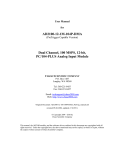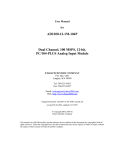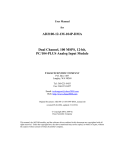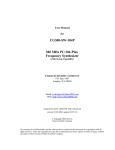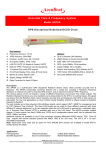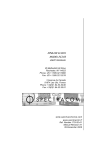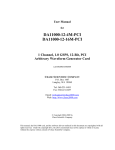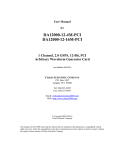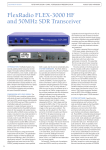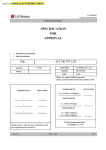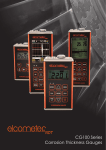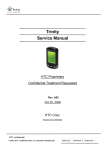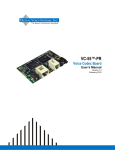Download User`s Manual V1 - Chase Scientific Company
Transcript
User Manual for CG400-PCI / CG100-PCI 400 MHz (CG400) / 100 MHz (CG100) PCI Based Clock Synthesizer CHASE SCIENTIFIC COMPANY P.O. Box 1487 Langley, WA 98260 Tel: 360-221-8455 Fax: 360-221-8457 Email: [email protected] Web: http://www.chase2000.com Original Document: CG400_manual.odt (created 05-06-2004, updated 6/17/2013) Copyright 2004-2010 by Chase Scientific Company This manual, the CG400/CG100 module, and the software drivers outlined in this document are copyrighted with all rights reserved. Under the copyright laws, the above mentioned may not be copied, in whole or in part, without the express written consent of Chase Scientific Company. CG400-PCI User Manual 400 MHz, PCI Clock Synthesizer TABLE OF CONTENTS 1 GENERAL INFORMATION...........................................................................................................................4 1.1 INTRODUCTION..................................................................................................................................................4 1.2 REFERENCES....................................................................................................................................................4 1.3 DELIVERABLES.................................................................................................................................................4 1.3.1 Software................................................................................................................................................4 1.3.2 Hardware..............................................................................................................................................5 1.3.3 Checklist................................................................................................................................................5 1.4 PRODUCT SPECIFICATION....................................................................................................................................5 1.5 TECHNICAL SUPPORT / SOFTWARE UPDATES.........................................................................................................6 1.6 WARRANTY.....................................................................................................................................................7 2 HARDWARE DESCRIPTION........................................................................................................................8 2.1 INTRODUCTION..................................................................................................................................................8 2.2 BLOCK DIAGRAM..............................................................................................................................................8 2.3 BOARD DRAWING.............................................................................................................................................9 2.4 BOARD I/O...................................................................................................................................................10 2.4.1 Header Pinouts and Pin Descriptions................................................................................................10 2.5 HARDWARE REGISTER DEFINITIONS...................................................................................................................10 3 THEORY OF OPERATION..........................................................................................................................11 3.1 INTRODUCTION................................................................................................................................................11 4SOFTWARE DRIVERS..................................................................................................................................11 4.1 INTRODUCTION................................................................................................................................................11 4.2 DRIVER INSTALLATION.....................................................................................................................................11 4.2.1 Windows 98/ME/2000/XP...................................................................................................................11 4.2.2 Linux Installation (Kernels 2.0x, 2.2x, 2.4x, 2.6x)..............................................................................12 4.2.3Windows NT4.......................................................................................................................................13 4.3 FUNCTION CALLS............................................................................................................................................13 4.3.1 Function Declarations in C................................................................................................................13 4.3.2 Function Call Descriptions / Usage...................................................................................................14 4.3.2.1 cg400_CountCards()....................................................................................................................................14 4.3.2.2 cg400_Open()..............................................................................................................................................14 4.3.2.3 da2100_Close()............................................................................................................................................15 4.3.2.4 cg400_initialize();........................................................................................................................................15 4.3.2.5 cg400_SetFrequency().................................................................................................................................15 4.3.2.6 cg400_WriteDDS_AD9858() [pre-Sept 1st hardware only}......................................................................16 4.4PROGRAMMING EXAMPLES................................................................................................................................17 4.4.1 Generic C Snippets.............................................................................................................................17 5MISCELLANEOUS.........................................................................................................................................17 5.1CALIBRATION..................................................................................................................................................17 5.2MAINTENANCE................................................................................................................................................17 © Chase Scientific Company (360)221-8455 2 CG400-PCI User Manual 400 MHz, PCI Clock Synthesizer ILLUSTRATIONS / TABLES FIGURE 1 – BLOCK DIAGRAM......................................................................................................................8 FIGURE 2 – BOARD LAYOUT.........................................................................................................................9 FIGURE 3 - 4-PIN DIGITAL I/O CONNECTOR..........................................................................................10 © Chase Scientific Company (360) 221-8455 3 CG400-PCI User Manual 1 400 MHz, PCI Clock Synthesizer GENERAL INFORMATION 1.1 Introduction The CG400 and CG100 are PCI based Clock Synthesizers with maximum output frequencies of 400 MHz and 100 MHz respectively. Each board has as standard the following features: - (1) 700mVpp Sinewave output, AC coupled. (2) 3.3V PECL Outputs, one normal / one inverted. (2) 3.3V TTL outputs, one normal / one inverted. (1) Clock input that can be jumper selected to be Master Clock for DDS (Direct Digital Synthesis) Both the CG400 and CG100 have a crystal based on-board clock sources which provides several orders of magnitude better phase noise that a PLL based design. NOTE: The model number CG400 in the following paragraphs represent both the CG100 and CG400 unless otherwise specified. This was done to simplify the manual. 1.2 References PCI Local Bus Specification, Rev. 2.1, June 1st, 1995. For more information on this document contact: PCI Special Interest Group P.O Box 14070 Portland, OR 97214 Phone FAX 1.3 1.3.1 (800) 433-5177 (U.S.) (503) 797-4207 (International) (503) 234-6762 Deliverables Software The CG400 comes with drivers for Windows 98/NT/2000/XP. Software comes on a single 3.5” diskette. Call Chase Scientific for the latest information on drivers for other operating system platforms or check the web site for the latest updates. Software drivers are provided as a Dynamic Link Library (*.DLL) which is compatible with most 32-bit windows based development software including Microsoft C/C++, Borland C/C++, and Borland Delphi. This DLL uses the “cdecl” calling convention which is default capatible with the compilers above and provides easy to use function calls to the system drivers “windrvr6.vxd” for Windows NT and “windrvr6.sys” for Windows 98/2000/XP. Actual Listing of files on Diskette/CD for Windows: ----------BASE_DIR D I R E C T O R I E S / F I L E S © Chase Scientific Company (360)221-8455 ---------------- 4 CG400-PCI User Manual 400 MHz, PCI Clock Synthesizer | | readme.txt // This file. | CG400_Ref_Dwg.pdf // Reference drawing for CG400 (connector descriptions) | AD9858_0.pdf // Analog Device's Data Sheet for DDS chip | | Register_cg400_Win98_2000_XP.bat // Installs Kernel driver for Win2000/XP | UnRegister_cg400_Win98_2000_XP.bat // Uninstalls Kernel driver for Win2000/XP | | Register_cg400_NT4.bat // Installs Kernel driver for Windows NT4.0 | UnRegister_cg400_NT4.bat // Uninstalls Kernel driver for Windows NT4.0 | | wdreg16.exe // Called by Register_cg400_Win98_ME_NT4.bat | wdreg.exe // Called by Register_cg400_Win2000_XP.bat | windrvr6.inf // Setup information file automatically called by above exe(s). | | cg400_dll.dll // DLL for 98/ME/NT4/2000/XP ( extern "C" __declspec(dllimport) ) | cg400_dll_import.h // Header file for DLL | cg400_dll.lib // Library file for DLL in Borland C++ | cg400_dll_msvc.zip // Include in MSVC Project to compile DLL above | example_snippet.txt // Example of function calls | | cg400_diag.exe // Simple GUI to test DLL and Kernel drivers | | CG400_PCI.inf // Plug-And-Play file needed by 98/ME/NT4/2000/XP for automatic | // hardware configuration. | | windrvr6.sys // Windows 98/ME/2000/XP Driver - copy this virtual driver | // to "c:\<windir>\system32\drivers\" if not automatically done | // so after running batch file. | | windrvr6.vxd // Windows NT4.0 Driver | -------------E N D ---------------- 1.3.2 Hardware The CG400 hardware consists of a single half-sized PCI Card. The card is shipped with a manual with complete hardware and software descriptions. This card can only be accessed as a PCI device according to PCI Local Bus Specification. 1.3.3 Checklist Item # Qty Part Number 1 1 CG400-PCI (or CG100-PCI) 2 1 CG400-Drivers 3.5” diskette with Dynamic Link Libraries for Windows 98/NT/2000/XP. Includes "example_snippet.txt". The same driver is used for both CG400 and CG100. 3 1 CG400-Manual User manual for CG400 and CG100 board and software drivers. 1.4 Description 1MHz - 400 MHz PCI Clock Synthesizer Card (1 MHz - 100 MHz PCI Clock Synthesizer Card) Product Specification (all specifications are at 25C unless otherwise specified) I/O SPECIFICATIONS © Chase Scientific Company (360) 221-8455 5 CG400-PCI User Manual Sine Output PECL 400 MHz, PCI Clock Synthesizer SMA Type Connector: 700mVpp (typical) Sinewave output from 1MHz to 400 MHz [CG400] 700mVpp (typical) Sinewave output from 1MHz to 100 MHz [CG100] 3.3V PECL Clock output. Frequency ranges same as Sine Out. (2) SMA Connectors, one Normal, one Inverted. ==> Option 2 changes this to LVDS. Tr/Tf = 300ns Typical when biased into 1.2V DC. 3.3V TTL Clock output. Frequency ranges same as Sine Out fir CG100, divided by 2 for CG400. (2) SMA connectors, one Normal, one Inverted. TTL Tr/Tf = 1ns Typical On-Board Clock Characteristics Phase Noise Jitter External Clock Input Frequenc Range Amplitude Range Input Impedance Coupling GENERAL Power Supply (Vcc) Operating Temperature Operating Humidity Size Data Bus 1.5 CG400 Phase Noise (Fc=100 MHz): <-100dBc/Hz @ 1KHz offset <-135dBc/Hz @ 1KHz offset (option 1) <-80dBc/Hz @ 1KHz offset (option 3) < -120dBc/Hz @ 1KHz Offset, Fc= 100 MHz [CG100] < 5 picoseconds [ bandwidth from 10MHz to Fmax] 1 MHz - 1.0 GHz for CG400; 1 MHz - 300 MHz for CG100 0dBm - 14dBm (square/sine wave) 50 ohms AC +12V @ TBDmA +3.3V @ TBDmA -12V @ TBDmA 0 to 70 degrees C standard -40 to +85 degrees C extended 5 to 95% non-condensing Half-Size PCI Card 32-bits PCI Technical Support / Software Updates For technical support: Phone Fax Email Mail (360) 221-8455 (360) 221-8457 [email protected] Chase Scientific Company P.O. Box 1487 Langley, WA 98260 For software updates: Email Web [email protected] http://www.chase2000.com © Chase Scientific Company (360)221-8455 6 CG400-PCI User Manual 1.6 400 MHz, PCI Clock Synthesizer Warranty Chase Scientific Company (hereafter called Chase Scientific) warrants to the original purchaser that its CG400-PCI, and the component parts thereof, will be free from defects in workmanship and materials for a period of ONE YEAR from the data of purchase. Chase Scientific will, without charge, repair or replace at its option, defective or component parts upon delivery to Chase Scientific’s service department within the warranty period accompanied by proof of purchase date in the form of a sales receipt. EXCLUSIONS: This warranty does not apply in the event of misuse or abuse of the product or as a result of unauthorized alterations or repairs. It is void if the serial number is altered, defaced or removed. Chase Scientific shall not be liable for any consequential damages, including without limitation damages resulting from loss of use. Some states do not allow limitation or incidental or consequential damages, so the above limitation or exclusion may not apply to you. This warranty gives you specific rights. You may also have other rights that vary from state to state. Chase Scientific warrants products sold only in the USA and Canada. In countries other than the USA, each distributor warrants the Chase Scientific products that it sells. NOTICE: Chase Scientific reserves the right to make changes and/or improvements in the product(s) described in this manual at any time without notice. © Chase Scientific Company (360) 221-8455 7 CG400-PCI User Manual 2 400 MHz, PCI Clock Synthesizer HARDWARE DESCRIPTION 2.1 Introduction The CG400 hardware consists of the following major functions: • (1) Sinewave Output [SMA] • (2) PECL/LVDS (norm + compl) [2 SMAs] • (2) TTL Outputs • (1) TTL, ECL, Sinewave Clock Input (AC coupled) 2.2 Block Diagram Figure 1 – Block Diagram © Chase Scientific Company (360)221-8455 8 CG400-PCI User Manual 2.3 400 MHz, PCI Clock Synthesizer Board Drawing Clk Input Sine Out +PECL Out -PECL Out +TTL Out -TTL Out Figure 2 – Board Layout for CG400/100 © Chase Scientific Company (360) 221-8455 9 CG400-PCI User Manual 2.4 2.4.1 400 MHz, PCI Clock Synthesizer Board I/O Header Pinouts and Pin Descriptions CG400 / CG100 CONFIGURATION NOTES: CG400 uses a maximum of 1.0 GHz internal/external clock while CG100 uses a maximum of 300 MHz Clock. JP2 1 2 3 4 5 6 7 8 1,2 shorted, 3,4 open ==> Used internally by CG400 to select on-board reference clock (10 MHz) 1,2 open, 3,4 shorted ==> Routes external clock to CG400 as internal reference clock (10 MHz) SHORT SHORT OPEN OPEN 2.5 5,6 5,6 5,6 5,6 and and and and SHORT OPEN SHORT OPEN 7,8 7,8 7,8 7,8 ==> ==> ==> ==> Uses Uses Uses Uses 1.0 GHz on-board Clock Source (CG400) 300 MHz on-board Clock Source (CG100) 1.0 GHz Low Jitter Clock Src (CG400) Clock Input (Sine/Square 0dBm-6dBm) Hardware Register Definitions Due to hardware protocol complexity, the details on how to use these ports are beyond the scope of this manual. The software drivers should provide an effortless integration path for the user. However, if the need arises that is beyond what the software drivers can provide, please call the factory for technical support. © Chase Scientific Company (360)221-8455 10 CG400-PCI User Manual 3 400 MHz, PCI Clock Synthesizer THEORY OF OPERATION 3.1 Introduction The CG400 is primarily comprised of a PCI target controller, a Direct Digital Synthesis (DDS) IC from Analog Devices, some filtering and signal buffers. The Analog Devices IC is the AD9858. For more information on this device you can download the data sheet from "www.analog.com". The software drivers include a special function call that allows the user to directly access this device. For general purpose use the "cg400_SetFrequency()" function call is much easier to use. 4 SOFTWARE DRIVERS 4.1 Introduction The primary objective in designing software drivers is to get the user up and running as quickly as possible. The details on installing software drivers are listed in 4.2.xx. While the listing of function calls and their parameter definitions are listed in section 4.3.xx, the programming examples in section 4.4.x will show you how to include them into your programs. The drivers are designed to work under Windows 98/ME/NT4/2000/XP. 4.2 4.2.1 Driver Installation Windows 98/ME/2000/XP 1) Do not install CG400 card at this time. 2) UnZip all files into directory "C:\temp\CG400\" (create directories if needed) You can move and/or copy the files later to a directory of your choice. 3) Run Register_CG400_Win98_2000_XP.bat. This will copy the Kernel driver windrvr6.sys to "c:\<windir>\system32\drivers\" directory and will register the Kernel driver in the Windows Registry so that it starts up each time the computer is rebooted. 4) Power off computer. Insert CG400 card. Power up computer. 5) When OS asks for Driver File point to "CG400_PCI.inf". If OS does not ask for file, then check hardware configuration and update if not listed properly under "Jungo" in Device Manager (see below). To check to see which driver is installed, do the following: => Control Panel => System © Chase Scientific Company (360) 221-8455 11 CG400-PCI User Manual 400 MHz, PCI Clock Synthesizer => Hardware => Device Manager => Jungo CG400_PC104P WinDriver If you see another driver in place of "CG400_PCI", then right click the first device under Jungo and click properties. Update the driver by pointing to "CG400_PCI.inf". You may have to go through a series of menus. 4.2.2 Linux Installation (Kernels 2.0x, 2.2x, 2.4x, 2.6x) Example Linux Installation on RH9.0 (version 2.4.20-8) ----------------------------------------------------- 02/04/2005 1. Before you start Install Red Hat Linux 9.0 (Kernel 2.4.20-8). Make sure the GNU C++ compiler, tools, and libraries are installed. This requires using the custom install mode or simply installing all packages. 2. Install the Kernel Driver Make sure you log on as administrator (root level). Copy the archive file "cg400.tgz" from the CD (or download) to the directory "/root/cg400" (for example). Open the cg400.tgz by using the archive manager "File Roller" or use "tar xvzf cg400.tgz". This will create two folders, "WinDriver" and "cg400_src" in this directory. Copy the "WinDriver" folder to the directory "/usr/local". This will create the directory "/usr/local/WinDriver" with all the support files needed to recompile the WinDriver Kernel. Type the following commands in a terminal windows while in directory "/usr/local/WinDriver/redist": A) # ./configure NOTE: The configure script creates a makefile based on your specific running kernel. B) # make C) # make install 3. Install the cg400 Interface Driver with Sample (user) Test Program. To compile sample test program change to directory "/root/cg400/cg400_src". Then type "make all". This will compile, link, and create the interface library cg400_o.o as well as the test application, cg400_test. Just use the test application as a skeleton for your own interface/application program. © Chase Scientific Company (360)221-8455 12 CG400-PCI User Manual 400 MHz, PCI Clock Synthesizer 4.2.3 Windows NT4 1) Do not install CG400 card at this time. 2) UnZip all files into directory "C:\temp\CG400\" (create directories if needed) You can move and/or copy the files later to a directory of your choice. 3) Run "Register_CG400_NT4.bat". This will copy the Kernel driver windrvr6.sys to "c:\<windir>\VMM32\" directory and will register the Kernel driver in the Windows Registry so that it starts up each time the computer is rebooted. 4) Power off computer. Insert CG400 card. Power up computer. 5) When OS asks for Driver File point to "CG400_PCI.inf". If OS does not ask for file, then check hardware configuration and update if not listed properly under "Jungo" in Device Manager (see below). To check to see which driver is installed, do the following: => Control Panel => System => Hardware => Device Manager => Jungo CG400_PC104P WinDriver If you see another driver in place of "CG400_PCI", then right click the first device under Jungo and click properties. Update the driver by pointing to "CG400_PCI.inf". You may have to go through a series of menus. 4.3 4.3.1 Function Calls Function Declarations in C //--------------------------------------------------------------------------#ifndef cg400_dllH #define cg400_dllH //--------------------------------------------------------------------------#define IMPORT extern "C" __declspec(dllimport) // USER FUNCTION CALLS ==> IMPORT DWORD cg400_CountCards(void); IMPORT DWORD cg400_Open(DWORD CardNum); IMPORT DWORD cg400_Close(DWORD CardNum); IMPORT void cg400_initialize(DWORD BrdNum); IMPORT void cg400_SetFrequency(DWORD BrdNum, float DDS_Frequency); IMPORT void cg400_WriteDDS_AD9858(DWORD BrdNum, DWORD DDS_RegAddr, DWORD DDS_RegValue); © Chase Scientific Company (360) 221-8455 13 CG400-PCI User Manual 400 MHz, PCI Clock Synthesizer #endif 4.3.2 Function Call Descriptions / Usage 4.3.2.1 cg400_CountCards() Description Returns number of CG400 cards present on computer. Declaration DWORD cg400_CountCards(void); Parameters none Return Value Returns with an encoded value which represents the number of CG400. Return Values: 0: Kernel Driver ok, but no card found 1-4: Normal range of possible number of cards detected 13: Kernel Driver not working Example DWORD Num_cg400_Boards = cg400_CountCards(); 4.3.2.2 cg400_Open() Description Loads the CG400 software drivers and sets the CG400 board to its default state. Declaration DWORD cg400_Open(DWORD CardNum); Parameters CardNum: 1 <= CardNum <= 4 Return Value Returns with error code. A "0" means everything is fine. See below for details for other values. Return Values: 0: Opened Windriver Successfully and CG400 Card Found Successfully 1: Opened Windriver Successfully, but NO CG400 CARDS FOUND 2: Opened Windriver Successfully, CG400 card found, but Cannot Open Driver to other Board Functions. 3: Opened Windriver Successfully, Board already open. 6: Card number exceeds number of cards. 13: FAILED TO OPEN Windriver Kernel Driver Example © Chase Scientific Company (360)221-8455 14 CG400-PCI User Manual 400 MHz, PCI Clock Synthesizer DWORD OpenErrorCode = cg400_Open(1); // Opens Board Number 1 and stores value. 4.3.2.3 da2100_Close() Description Closes CG400 drivers. Should be called after finishing using the driver. However, if no other software uses the “windrv.xxx” (usual situation), then there is no need to close it until user is ready to completely exit from using their main software program. Declaration DWORD cg400_Close(DWORD CardNum); Parameters CardNum: 1 <= CardNum <= 4 Return Value Returns with error code. A "0" means everything is fine. See below for details for other values. Return Values: 0: Closed Windriver Successfully for CG400 card requested. 5: CG400 Card Already Closed for card requested. 13: FAILED TO ACCESS Windriver Kernel Driver Example DWORD CloseErrorCode = cg400_Close(1); 4.3.2.4 cg400_initialize(); Description Sets up DDS chip so that programming can be performed. Declaration void cg400_Reset(DWORD BrdNum); Parameters CardNum: 1 <= CardNum <= 4 Return Value None. Example cg400_initialize(1); 4.3.2.5 cg400_SetFrequency() Description Sets internal clock rate based on on-board clock or external clock (DivideBy=8). Declaration void cg400_SetFrequency(DWORD BrdNum, float DDS_Frequency); © Chase Scientific Company (360) 221-8455 15 CG400-PCI User Manual 400 MHz, PCI Clock Synthesizer Parameters BrdNum: DDS_Frequency: 1 <= CardNum <= 4 DDS_Frequency <= (0.4)(Master Clock) [CG400 = 1000000000] [CG100 = 300000000] NOTE #1: For CG100, must multiply desired frequency by 3.333... since it uses same software as CG400, but different oscillator with 1/3 the master clock.. NOTE #2: The TTL outputs of the CG400 are divided by 2 to prevent the outputs from going about 200 MHz. There is no divider for the CG100 (TTL same as LVDS, PECL, and Sine Out). Return Value None. Example cg400_SetFrequency(1,100); // Set board #1 to 100 MHz (CG400) or 30 MHz (CG100) 4.3.2.6 cg400_WriteDDS_AD9858() [pre-Sept 1st hardware only} Description See data sheet for AD9858 from Analog Devices. Declaration void cg400_WriteDDS_AD9858(DWORD BrdNum, DWORD DDS_RegAddr, DWORD DDS_RegValue); Parameters BrdNum: 1 <= CardNum <= 4 See data sheet for AD9858 from Analog Devices for DDS_RegAddr, DDS_RegValue. Return Value None. Example cg400_WriteDDS_AD9858(1,0x00, 0x0000407E); // Set board #1 Sleep © Chase Scientific Company (360)221-8455 16 CG400-PCI User Manual 4.4 4.4.1 400 MHz, PCI Clock Synthesizer Programming Examples Generic C Snippets Standard Sequence of Function Calls ==> cg400_CountCards(); cg400_Open(1); // Check to see if card is there // Opens cg400 Kernel Driver Access cg400_initialize(1); // Initializes card # 1 cg400_SetFrequency(1, 155520000.00); // Sets Frequency to 155.52 MHz cg400_Close(1); 5 // Run this before quitting program MISCELLANEOUS 5.1 Calibration The CG400 has no user feature to calibrate for input and output gain accuracy or offsets. T 5.2 Maintenance No maintenance is required. However, a yearly calibration is recommended if the user desires to maintain the CG400 modules’ specified accuracy. Call factory for maintenance and/or extended warranty information. Trademarks: MS-DOS, Windows 3.1, Windows 95, Windows NT, Windows 2000, and Windows XP are registered trademarks of Microsoft Corporation. © Chase Scientific Company (360) 221-8455 17

















